"The Face Is Familiar..."
It’s a popular belief — or at least a staple
of adventure fiction — that every one of us has a
double, someone somewhere out there who looks exactly like
us. I guess it only makes sense, then, that a guy like Superman,
who does everything on a grander scale than mere humans,
has even more duplicates. A lot more.
The most famous dead ringer for the Man of Steel is dear
old Dad himself, Jor-El. Throughout the
legend, Krypton’s greatest scientist is shown to have
strongly resembled his famous son. In fact, it’s safe
to say that physically he’s pretty much just Superman
in a headband. Way back in Superman #61 (1949),
a trip to the Krypton of the past gives Superman his first
look at his father, and even before he deduces their connection,
he can hardly miss the resemblance.

Over time, Jor-El’s “costume” would undergo
many changes, but not his face, which remained a mirror
image of his son’s. I suppose the idea was to reinforce
the father-son bond by keeping the resemblance so strong;
since we’d come to associate Superman’s features
with heroism, giving Jor-El the same face was a signal he
shared a lot of his son’s other traits. In fact, over
time this tradition was so well-established that when Superman:
The Movie finally came out I was put off by its heavy-set,
white-haired geezer of a Jor-El…who looked nothing
like Christopher Reeve. I don’t know, maybe in the
back of my mind I just assumed they’d get the same
actor to play both roles.
Anyway, there’s some evidence that the El family
simply had a very strong gene pool. In Lois Lane
#15 (Feb. 1960), we meet the young Kandorian scientist Van-Zee,
who despite being a mere cousin is also virtually indistinguishable
from Superman (and thus Jor-El).

Using Kandorian monitors to follow Superman’s adventures,
Van-Zee falls in love with Lois Lane from afar and leaves
Kandor to woo her in person. She turns him down, but since
after all true love is mostly a matter of looks, he searches
the world over for a Lois lookalike. Ultimately he finds
one in the form of wealthy heiress Sylvia DeWitt
and takes her back to Kandor, where they raise a family.

Over the years, Van-Zee proves himself a valued ally of
Superman and in time assumes the mantle of Kandor’s
resident superhero Nightwing, a role originated by his cousin
Kal.
Obviously, a friendly lookalike comes in mighty handy when
protecting a secret identity, and besides Van-Zee there
were several such helpers, including Kell Orr of
the planet Xenon, whose father Zoll Orr looks just like
Jor-El (logically enough). In Superman #119 (Feb.
1958), Kell Orr fills in for Superman on Earth while the
real deal is on Xenon averting a galactic catastrophe.
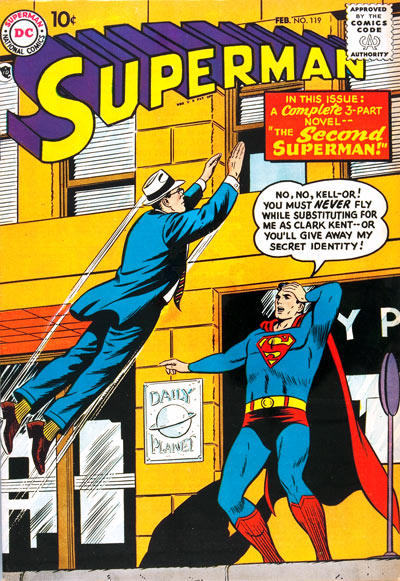
In Action Comics #265 (Jun. ’60), we meet
yet another heroic double on yet another planet, and this
time Superman gets to return Kel Lor’s favor…sort
of. On the Earth-like planet Oceana, the hero known as Hyper-Man
forges a career that closely parallels Superman’s;
he was rocketed from a doomed planet as an infant, gained
super-powers on his new world, adopted a secret identity
with the initials CK (Chester King) and is harassed by/in
love with a girl reporter with the initials LL (Lydia Long).
Superman so closely resembles Hyper-Man that he’s
able to fill in as “Chester King” to help preserve
the hero’s secret identity (although it doesn’t
turn out that way, but that’s another story).
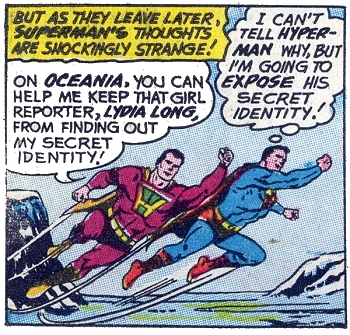
Alas, not all Superman dopplegangers used their heroically
handsome features for niceness. In Action Comics
#252 (May ’59) we meet John Corben,
a crooked reporter whose body is irreparably damaged in
a car accident, resulting in experimental surgery that turns
him into the half-human, half-robot supervillain, Metallo.
Realizing that “with my mustache shaved off I could
pass as Superman’s twin,” Corben disguises himself
as the Man of Steel and attempts to kill both him and Lois.

On numerous occasions, Superman’s “double”
was Superman himself, as exposure to Red Kryptonite split
him into two physically identical beings, first in Action
Comics #293 and again in Action Comics #311
(April 1964). In both cases, the Red-K “twins”
were in conflict, as one was a super-powered but evil Superman
and the other was a powerless but good Clark Kent. Remembering
these incidents, Superman deliberately splits himself into
two equal beings in the celebrated Imaginary Tale, “The
Saga of Superman Red and Superman Blue,” only this
time both Supermen have powers and both are good (Superman
#162, July 1963). Between them they pretty much solve all
of Earth’s problems once and for all.
It’s debatable whether those literal duplicates belong
on a list of lookalikes, but one similar creation certainly
does: Super-Menace, a living copy of Superman,
is created when a freak cosmic force strikes baby Kal-El’s
rocket on its way to Earth (as revealed in Superman
#137, May 1960). While Kal-El lands near Smallville to be
adopted by the kindly Ma and Pa Kent, his infant duplicate
is found and raised by a husband-and-wife team of petty
thieves and con artists. This corrupting influence in his
formative years turns the second Superman to evil, eventually
bringing him into conflict with the Man of Steel.
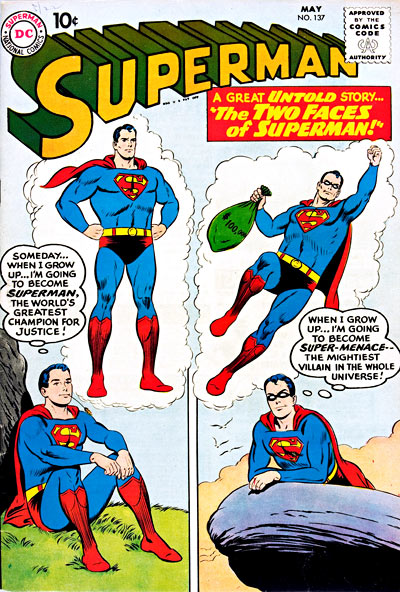
As he is, after all, a creature made of pure energy and
not organic tissue, Super-Menace is pretty much doomed from
the start, and sure enough he explodes at story’s
end, making sure to take his hated parents with him to oblivion.
Almost exactly a decade later in Superman #225 (Apr. 1970),
a similar incident results in yet another duplicate Superman
when aliens aim a ray at the Action Ace as he travels in
deep space, creating a ”living, breathing, hyper-plastic
copy of Superman” without his knowledge.
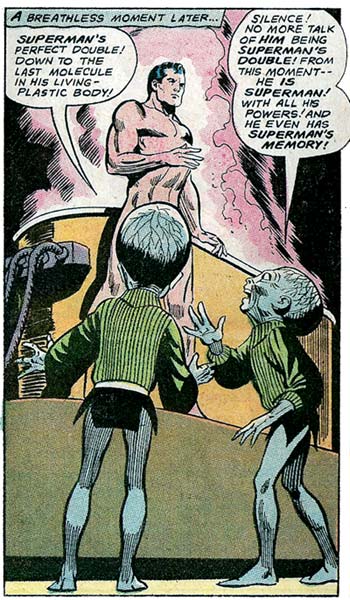
The intent is to send the ersatz Superman to Earth —
convinced by the aliens that he’s the real deal —
so he can steal the real hero’s powers and, under
the mind control of the aliens, assist in an invasion of
Earth. The plan backfires when the fake Man of Steel commits
suicide at story’s end.
Much more committed to the cause of evil was Mala,
one of three Kryptonian criminals rocketed into space on
a prison ship by Jor-El in the pre-Phantom Zone era. In
his second visit to Earth (Action Comics #194,
July ’54), Mala attempts to get close enough to Superman
to kill him by assuming the identity of his “close
friend” Clark Kent.

Frankly, Wayne Boring‘s art on this tale makes it
unclear whether Mala is supposed to be a natural lookalike
for Superman/Kent; sometimes he looks like him, sometimes
he doesn’t. On the cover, he’s shown thinking
“I’m disguised as Clark Kent,” but in
the panel above, he implies the disguise is limited to the
glasses. It’s possible Mala applied makeup or one
of those Mission: Impossible-style rubber masks
as part of his disguise, but if so it happened off-panel
and is never mentioned, and since the mythos has a long
tradition of considering a flimsy pair of horn-rims a complete
“disguise,” I’m keeping him on the list.
So together with Jor-El and Van-Zee, Mala makes three Kryptonian
duplicates of Superman, but the number grows considerably
when you factor in the population of Kandor, apparently
simply teeming with Superman twins. Several of them band
together to form the Superman Emergency Squad,
a force of miniature, super-powered helpers chosen based
on their “close resemblance” to the hero (Van-Zee
is a member). Here we see them harassing Supergirl
on the cover to Action Comics #276 (May 1961).
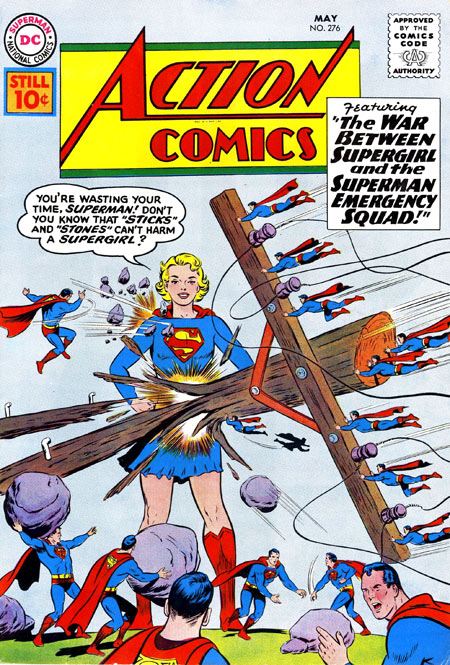
Perhaps realizing the extreme statistical improbability
of an entire gang of Superman carbon copies living in a
single city, later versions of the Squad dropped the lookalike
angle. However, we might reasonably assume one alumnus of
the original team was Vol-Don of the Kandorian
Look-Alike Squad, made up of dead ringers for everyone
in Superman’s inner circle, including Perry
White, Jimmy Olsen, Lois Lane and Lana
Lang. Vol-Don is the team’s “Clark
Kent look-alike” (which naturally means that without
the specs, he’s a double for Superman).
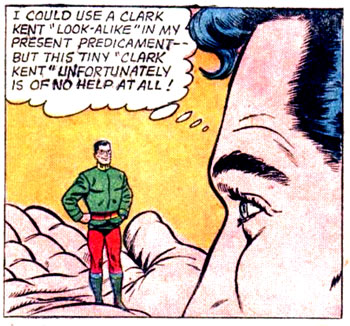
This story raises the interesting question: If Van-Zee’s
“love” for Lois Lane could be satisfied with
any Lois lookalike, why search Earth for one when there’s
already a Lois clone in the bottle with him?
The most commonly used lookalikes in the mythos are the
Superman robots, created by Superman to
fill in for him in his heroic guise and also as Clark Kent.
Though he tends to consider them mere devices, the robots
exhibit loyalty, courage and on occasion ingenuity and independent
thinking that supports the argument they are a form of independent
and intelligent, albeit mechanical life. In Superman #163
(Aug. 1963), one of these robots shows up as Wonder-Man,
having received an upgrade from aliens that makes him a
match for Superman, although as part of the makeover he
loses his resemblance to his former master. Not so
Android-I, a sophisticated artificial lookalike
created by Superman in Superman #174 (Jan. 1965). After
a lab accident at the Fortress of Solitude makes Superman
believe his creation has been destroyed, Android-I returns
to assumes his creator’s identity and make a suddenly
powerless Clark Kent doubt his own sanity.
A more convoluted twist on this premise occurs in Superman
#198 (July 1967), when a duplicate Clark Kent bursts into
the Daily Planet, exposing Superman’s secret identity
with an “x-ray gun.”
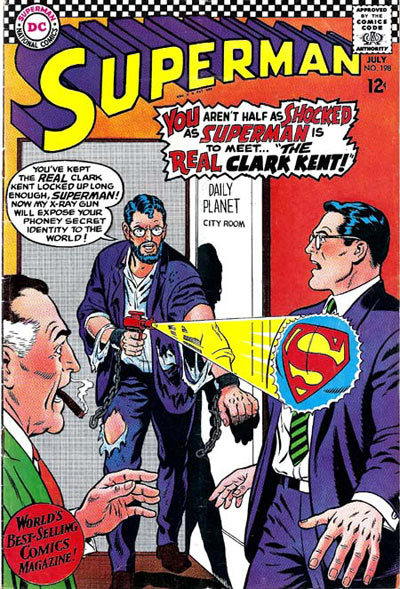
The duplicate Clark turns out to be from a parallel Earth
where “Clark Kent” is a genuine Earth man and
“Superman” is evil. Traveling to this second
Earth, our Superman does battle with his evil counterpart
but in due course it’s revealed that the second Clark,
the second Superman and indeed the entire population of
the parallel Metropolis are androids populating a fake Earth
as part of an elaborate ruse (to say the least) by the Superman
Revenge Squad.
With a bit of imagination, Superman lookalikes are also
perfect fodder for Lois Lane stories. For instance, in Lois
Lane #3, our favorite girl reporter is in the “small
waterfront town” of Hadley when she meets Mark
Benton, a man who looks just like Clark Kent, but
behaves in a much more manly fashion.

Lois and Benton enter into a whirlwind romance, which ends
in heartache when Benton tires of Lois’ constant snooping.
Lois suspects Benton of being the mysterious “Robin
Hood” character who’s been distributing stolen
money to the needy. It turns out she’s right, except
that the money isn’t stolen; it belongs to Mark in
his true identity as Ronald Van Horton, richest man in town.
Since Lois wouldn’t trust him, though, he breaks off
their relationship, costing her a shot at marriage and millions.
At least Lois learned a valuable lesson that made her into
a better person, right? Fat chance. Years later, in Lois
Lane #24 (Apr. 1961), a match-making computer selects
as Lois’ ideal mate the handsome sportsman Roger
Warner, who just happens to look exactly like Clark
Kent, though he sure doesn’t act like him.

Charming, cultured, multi-lingual, athletic, good-looking,
wealthy and even (as he proves by saving a drowning woman)
heroic, Warner has everything Lois could want in a man.
Everything, that is, except hair. When it’s revealed
that Warner wears a wig to cover his bald dome, Lois recoils
in horror, causing Warner to run away and break off their
romance. “But his baldness wouldn’t have mattered,”
thinks Lois, “…or would it?” Later we
get our answer when Lois declares she’s going back
to pursuing her true love: “At least I’m sure
that Superman won’t lose his hair!”
Some “doubles” turn out to be red herrings.
In Action Comics #341 (Sept. 1966), what seems
to be a second Clark Kent — with super-powers, yet
— is revealed as the Phantom Zone villain Professor
Vakox, who without the aid of a rubber mask looks
nothing at all like Superman. The fact that he does don
the disguise suggests editor Mort Weisinger saw doubles
as a sales tool in the Silver Age. We already know Julie
Schwartz believed in the power of “gorilla”
covers to sell comics; apparently Mort liked the way “doubles”
sold Superman comics. Otherwise you’d think the promise
of a battle with a super-powerful Phantom Zone foe would
be incentive enough for a kid to plunk down his 12 cents.
Instead we get this cover, which despite showing Superman
and “Clark Kent” throwing cannon balls at each
other (big whoop) is chiefly concerned with making us believe
both combatants are “genuine.”

In Action 371
(Jan 1969), a spy working for an unnamed foreign power kayos
Clark Kent and, since he looks just like him, assumes his
identity to carry out a campaign of espionage against the
United States. A freak accident causes Superman to forget
his secret identity, kicking off a four-part storyline in
which he tries out various new ones while the fake Clark
continues his masquerade, ending in Action Comics
#475 with a showdown with the impostor and the other members
of the spy ring.
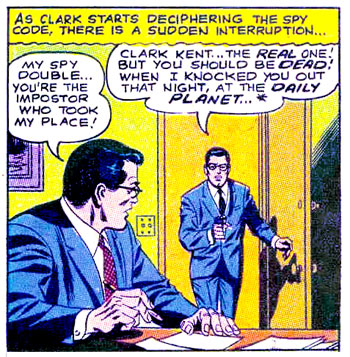
The famous “Kryptonite No More” in Superman
#233 ends with the creation of yet another energy-based
Superman double. This one would sometimes be known as “the
Quarrmer,” due to his origins in the alternate
dimension of Quarrm, but is more famously know as the Sand
Superman, as his body is made of sand from a desert
somewhere in the Western U.S. Though he fights Superman
at various points, the Sand Superman isn’t completely
villainous. As they say, “it’s complicated,”
but in short his existence depends on powers stolen from
Superman, making him central to writer Denny O’Neill’s
plan to refit the Superman mythos for the 1970s with a less
omnipotent Man of Steel.

Another “Bronze Age” lookalike is actor Gregory
Reed, the man who plays Superman on Earth-1 television.
First encountered in Action Comics #414 (July ’72),
Reed is successful and wealthy thanks to his career as a
small-screen superhero, but also bitterly resentful that
typecasting has ended his ability to win other roles. His
resentment is especially acute since a fire on set left
him disfigured; his resulting dependency on heavy make-up,
coupled with the use of “lifts” and fake muscles,
makes him feel like a total fake, and hateful towards the
real deal. With the aid of black magic, Reed temporarily
switches bodies with Superman, but once restored, Superman
takes pity on Reed and later gives him plastic surgery to
restore his lookalike features. In subsequent stories, Reed
is shown to be a friend and helper to Superman.
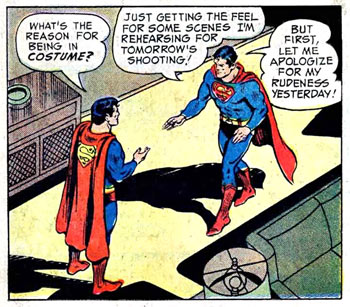
I’m probably forgetting plenty of examples, but those
are the ones that jump immediately to mind. As much as this
preponderance of super-clones strains credulity, it does
in a cock-eyed way lend support to one of the central conceits
of the whole Superman mythos. If there really are so many
dozens of men running around with the same face, then it
must be a lot easier for the people of Metropolis to swallow
the notion that Clark Kent and Superman are two separate
people. Indeed the glasses may not even be necessary; with
so many lookalikes running around, the red cape and blue
long-johns are about the only things that make Superman
at all physically remarkable.
Without those gaudy duds, he’s just a face in the
crowd.


















